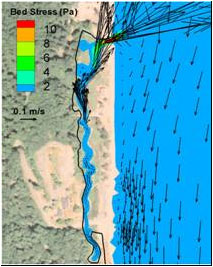SSM Habitat Restoration: Whidbey Basin Pocket Estuaries
Restoration of Pocket Estuaries at Possession and Camano State Parks, Washington

Research by Skagit River System Cooperative (SRSC) and others indicates that small, non-natal estuaries (pocket estuaries) within Whidbey Basin are preferred 20 to 1 by endangered Chinook salmon for nearshore rearing during the early stages of their out-migration. Multiple salmon stocks (Skagit, Stillaguamish, and Snohomish) likely use estuary sites, like Possession State Park, along the Saratoga Passage corridor after leaving their natal deltas. A total of 96 historic pocket estuaries within the Whidbey Basin region have been identified. All but 26 of these have either been completely destroyed or are too small to be sustainably maintained for fish habitat.
SRSC proposed a restoration feasibility assessment study to evaluate the possibility of providing the desired estuarine tidal marsh habitat for fish. As part of feasibility assessment, there was considerable interest in evaluating stability and long-term sustainability of the created estuaries. Battelle developed an unstructured grid hydrodynamic model of the Whidbey Basin that focuses on the nearshore environment. The model simulates tidal circulation, wetting and drying of marshlands and mudflats, and the transport processes of freshwater river plumes, sediment, and water quality in the Whidbey Basin. The approach was to extend the model domain into the selected pocket estuaries by adding the required resolution and evaluating the feasibility of opening and sustaining estuarine processes in the new configuration.

A modeling-based evaluation of the feasibility of restoring the selected pocket estuaries—Possession Park and Camano State Parks—was conducted. The model application provided information to help answer questions related to the long-term stability of the created tidal channels and estuary openings.
Project Highlights
- Channels and marsh areas dried out completely during low tide before high tide inundation.
- Velocities in the estuary were found to be relatively small.
- During ebb tide the peak velocities reached 1.5~2.0 m/s at the tidal channel entrance.
- Peak bed shear stress reached 10 Pa at the entrance but far less than the critical shear stress for cobbles (~50 Pa for 5 cm diameter).
- Results showed that it may be necessary to dig pools to retain water during low tide.
- Beach sediments were not moved by tidal currents but were transported by strong wave actions.
Contacts and Project Team
- PNNL: Tarang Khangaonkar (CO-PI), Cheegwan Lee (CO-PI)
- Skagit River System Cooperative: Aundrea McBride (CO-PI), Eric Beamer (PI),
Study Reports and Publications
McBride A, EM Beamer. 2010. Feasibility Assessment for Salt Marsh Restoration at Camano Island State Park, Whidbey Basin. Skagit River System Cooperative, Mount. Vernon, WA.
McBride A, EM Beamer. 2010. Feasibility Assessment for Salt Marsh Restoration at Possession Park, Whidbey Basin. Skagit River System Cooperative, Mount. Vernon, WA.